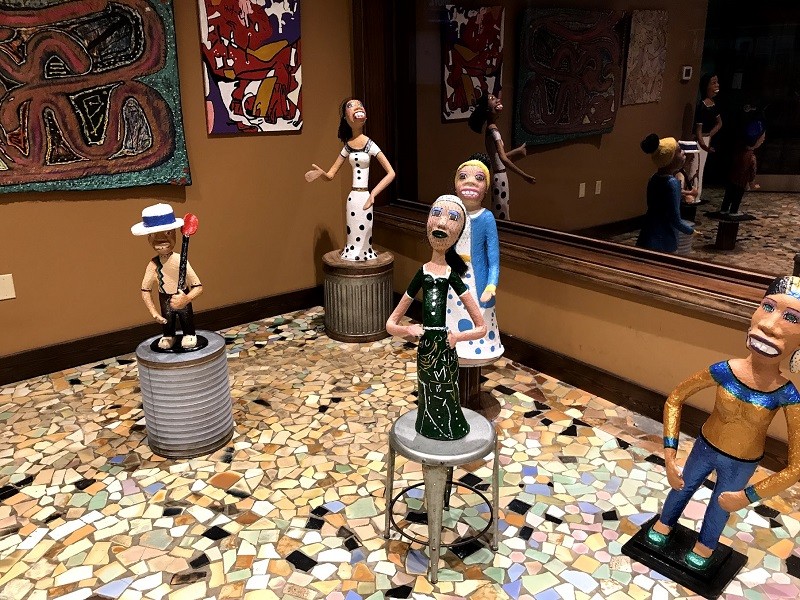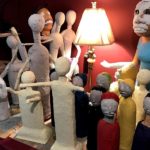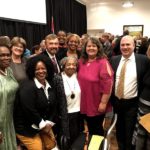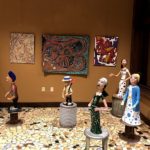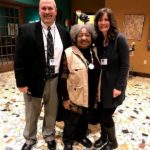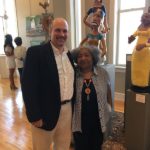I hadn’t known Hattie Duncan more than ten minutes when she took my arm in hers, looked me straight in the eyes, and spoke with all the conviction of an evangelist about the interdependence of personal creativity and genuine forgiveness.
It’s rare, and truly startling, to be confronted with such hard-earned wisdom and honest introspection in a social setting. I’ve sat through sermons with far less spiritual content. But that’s just how she speaks: with clear-eyed self-awareness and prescient spirituality that leaves you wondering what she might know about you.
I typically find it off-putting when strangers assume casual familiarity, but something in her demeanor disarmed me immediately. How could I have known, in that moment, that I was sensing the artist’s openness to me as a fellow traveler with a story worth hearing, and maybe even worth retelling in her own medium? How could I have known that she saw our first meeting as the merging of two spiritual journeys rather than a casual conversation between strangers? Clearly, there was a lot I didn’t know about Hattie Duncan.
What I did know was intriguing. I had seen photos of her wildly imaginative sculptures and knew that Hattie was a self-taught artist who was just beginning to get some well deserved recognition in folklife circles. I was eager to see her work exhibited alongside the spectacular folk art acquisitions in the Caldwell Collection at the West Tennessee Regional Art Center. Center director and dear friend, Bill Hickerson, had invited me to the exhibit opening and made the introductions. I am forever in his debt.
In those first few moments, it was more than obvious that the artist I had come to see had my number. It’s a slightly unsettling—albeit oddly irresistible—quality, and I would not trust anyone who didn’t fall in love with Hattie Duncan immediately. Her creativity is admirable on its own terms, but she has a way of being in this world that is impossible to ignore.
Hattie already had many dedicated votaries by the time I met her in the spring of 2017. It didn’t take me long to understand why. She is more than a talented visual artist, she is a sage and a spiritual luminary of contemporary folk art. She has thought deeply about what it means to be creative and speaks authoritatively to the interwoven workings of human hearts and hands. When asked about her process, she is more likely to talk about love and acceptance than artistic vision and technique. Indeed, those subjects seem an inexhaustible source of fascination for her. She’s had plenty of time to think it over.
Disabled as a child with polio, Hattie was sidelined for many of the normal physical pursuits of childhood. She spent her time emulating her father’s pencil drawings and improvising paintings or small sculptural figures out of mud, clay, found objects and melted crayons. No one really took notice, but the creative impulse and the power of her imagination continued to grow as she nurtured them in solitude. They bloomed again in unexpected ways after she made peace with the privation and neglect of her early years.
The same sense of penetrating spiritual awareness that informs her word imbues her work with an etherial quality. The figural works, which have garnered the most attention in the art world, are anything but subtle. Their substantial mass, brilliant painted finishes, exaggerated features and dazzling adornments demand one’s attention. Each piece, constructed of recycled or found items and Hattie’s own “paper clay” recipe, is as individual as a human fingerprint. Most of the sculptures are, in fact, inspired by flesh and blood people from Hattie’s circle of friends and family. The whimsy, loving intimacy, and frequent mischievousness in the portrayals are a feat of artistic achievement which breathes life into each three-dimensional portrait. One has the distinct sense that a grouping of her figures might well carry on a conversation amongst themselves once exhibit goers are out of earshot.
I had the great privilege of seeing Hattie recognized with the Tennessee Governor’s Folklife Heritage Award, the state’s highest honor in the traditional arts, last fall. As one would expect, she accepted that award with grace and humility. There was something almost regal in her bearing that evening. Certainly, it was a satisfying validation of one woman’s disgracefully under-appreciated artistic vision, but I couldn’t help thinking it was also a kind of victory for the untutored and the unheralded makers on the margins; the dreamers and believers who refuse to let hardship extinguish the light of creativity; the differently and powerfully abled; the forgivers.
Hattie once asked if I believed creativity was connected to spirituality. We were sitting at her kitchen table sipping coffee. I know it was an honest question, but it was also a call to confession; it was abundantly clear what she thought about the matter. I had been thinking about our first encounter since the day it happened and I was ready with an answer.
God first revealed himself to humanity as Creator, while at the same time declaring humankind was made in his image. So, I told the wise woman of Tennessee folk art I took that to mean all people had a spark of divinely inspired creativity, but only a few possessed the self-awareness to harness it as she had done. It is one thing to learn a creative technique, but quite another to shine light into darkness with the power of your own creative energy. That’s a spiritual calling as much as an artistic one.
There was a long pause while she seemed to consider that. Her eyes narrowed and a faint smile tugged at one corner of her mouth. She tilted her head slightly, appraising me for a long moment in that knowing way of hers. Finally, she said, “I think you may be right.”
If Hattie Duncan endorses that sentiment, I accept it as gospel.
About The Author
Shawn Pitts is an avocational folklore enthusiast, musician and writer living and working in West Tennessee. His writing has appeared in Southern Cultures, Tennessee Magazine, The Bitter Southerner, and The Tennessee Folklore Society Bulletin. In 2012 he was awarded by the American Folklife Center, Library of Congress for music heritage preservation efforts in his native Southwest Tennessee. Shawn is a past president of the Tennessee Folklore Society and currently serves on the boards of Humanities Tennessee and the Tennessee Arts Commission. Shawn’s “Only The Stones Remain ” was named a Best of 2019 Winner on Y’all.com
Selmer (Tenn.) Is Embracing It’s Heritage And Drawing International Crowd


